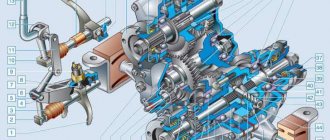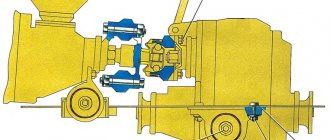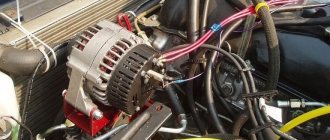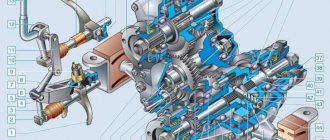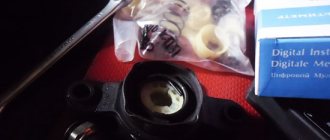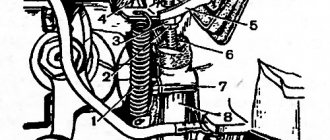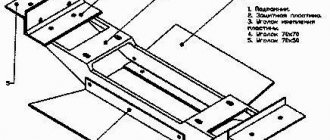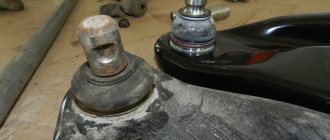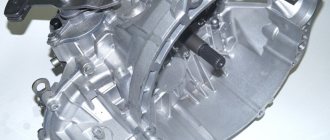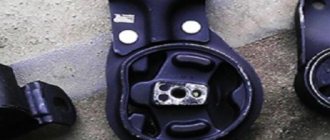The topic, vibrations in the Niva, is probably the subject of the largest number of articles dedicated to the Niva family. Most of them, as always, are quite general. Recommendations as a carbon copy: replace the universal joints with CV joints, center the transfer case and you will be happy. But all this is a fight against “first order” vibrations, from which the car simply shakes. I want to talk about vibration in the “second order” field and methods of struggle. As a rule, it manifests itself either in the form of “seasickness” or in the form of shaking mirrors, when it is impossible to read the license plate of the car driving behind. That is, you don’t feel any obvious vibrations, but when you get out of the car after a long drive, you are left with something “wrong” in your head.
Removing the Niva transfer case
To repair the transfer case on a VAZ 21213 (21214), the unit must first be removed. We carry out removal in the following order:
- in the cabin we dismantle the plastic lining of the gearbox and gearbox levers;
- unscrew the knobs of the transfer case shift levers, remove the casing under them;
- disconnect the speedometer cable, for RK 21214 you will need to additionally disconnect the speed sensor;
- we unscrew the bolts with nuts securing the elastic coupling of the front and rear propeller shafts; in order to remove the bolts, the cardan shafts must be turned - they are removed one at a time in one specific position of the shaft;
- We install a jack (or other support) under the transfer case and mark the places where the side supports of the RC were attached. This is done in order to minimize the alignment of the transfer case during installation;
- unscrew the 4 nuts securing the gearbox to the gearbox;
- unscrew the 4 fastenings of the RC supports to the car body;
- Now all that remains is to dismantle the transfer case.
Replacing transfer case cushions Niva 21214
Good day, dear readers!
1)
I didn’t tighten it and wait for the RC to fall off, the studs were bald, I had to make 2 nuts everywhere. I already did this at the checkpoint, I liked it.
Having previously disassembled the interior and removed the seats, we cut off the studs and drill holes:
One hole, which is closer to the engine, goes directly under the seat mount, cut a thread there and screw in a stud from the bottom, choose the thickness of the studs yourself. I installed the studs M8
Access to the second hole is absolutely free from the interior, so I installed an M10 bolt and secured it by welding. I anointed it with mastic on all sides:
2)
It came to the third support and pillows 21214. The studs for the third support were made in the same way as above, the support itself and pillows 21214 were installed without problems, fortunately the kit came with long studs.
I poured two tubes of additive into the RK:
Installed it all, centered it well together with the Niva master
And I thought I’d be happy to drive now, but not entirely.
—
The third support of the transfer case is not an unambiguous thing, and the levers have stopped chattering, but it does not eliminate vibrations as many expect. I wanted to get rid of minor vibrations in neutral in the region of 80-90, in the end I just increased their range, they became 60-90. Well, what I didn’t like most of all was a howl, when you drive for the third 20-30 km/h hour and press the gas pedal a little, everyone’s RK howls, this howl became even louder, it was very depressing.
However, if you don’t have an ear for music and the car is rarely used in the city, then the support will be very useful, the rk sits very stable, no vibrations under load. But for myself, I decided that I didn’t need it and decided to take it off.
Here I was even more surprised, I removed the support, and the handles still didn’t dangle as much as before. The merit of pillows 21214? Or was the RK simply better displayed? I don’t know what, but I solved my problem without a third support.
If you decide to install it, you need to make oval holes in the mount so that the RK can be positioned more accurately. And I would advise you to think again whether it is necessary. There are many reviews that on a regular Niva the transfer case dampens these vibrations with its vibrations; if you hold it, the vibrations will be felt by the driver and everyone in the cabin. Yes, and driving without it didn’t bother me much, but now with the 21214 pillows and more precise alignment it’s even better.
Now I’m ready to sell the third support, mileage 100 km, but only KMV or pick-up. Details in PM.
Eliminate vibration with additional fasteners
The Niva family of cars differs from VAZ passenger cars in permanent all-wheel drive - they have two drive axles. In total, the VAZ SUV has three differentials in its transmission - one for each axle and another center differential.
1. Oil seal; 2. Thrust ring of the front bearing of the drive shaft; 3. Front bearing cover; 4. Front drive shaft bearing; 5. Transfer case front cover; 6. High gear; 7. Gear clutch hub; 8. Gear clutch; 9. Low gear; 10.
Transfer case housing; 11. Rear drive shaft bearing; 12. Drive shaft; 13. Transfer case rear cover; 14. Intermediate shaft; 15. Rear intermediate shaft bearing; 16. Rear differential housing bearing; 17. Installation ring of the rear axle drive shaft bearing; 18. Rear axle drive shaft bearing; 19.
homemade all-terrain vehicle CHEBOKA first voyage 1
Differential housing bearing retaining ring; 31. Differential locking clutch; 32. Front axle drive shaft; 33. Front axle drive housing; 34. Retaining ring of the front axle drive shaft bearing; 35. Differential bearing spring washer; 36. Front differential housing bearing; 37.
Speedometer driven gear; 38. Speedometer drive housing; 39. Front intermediate shaft bearing; 40. Gearbox; 41. Elastic coupling; 42. Constant velocity joint; 43. Transfer case; 44. Shims; 45. Transfer case suspension bracket; 46. Rear engine mount bracket.
I. High gear engaged; II. Low gear engaged; III. Low gear is engaged, differential is locked.
The Niva transfer case is designed to distribute traction forces between axles, and operates on the principle of a 2-speed gearbox.
- driveshafts are poorly secured;
- wheels are not balanced;
- there is play in the cardan crosspieces (vibration is especially affected by play in the rear driveshaft crosspieces);
- The vibration comes from the engine itself.
Vibration when starting off on a Niva can also occur for the following reasons:
Installation and repair of the transfer case of the VAZ 2121 Niva
- the mounting supports of the transfer case have become loose;
- The rubber on the RK supports themselves broke.
Installing the third support of the transfer case on VAZ 21213/21214 vehicles allows you to reduce the level of vibration of the transfer case; with this support it is easier to center the transfer case. The part can be purchased at auto stores or made yourself. The finished product comes with three long studs (for model 2121); to install the third support on this machine, you will need to unscrew the short studs from the transfer case housing and install new studs from the kit. We carry out repairs as follows:
- dismantle the front passenger seat in the cabin;
- remove the floor tunnel lining;
- in the cabin we move aside the carpet covering the body amplifier (in front of the handbrake lever);
- remove the transfer case (alternatively, you can simply hang it up, but removing the third support makes it easier to install);
- We attach the bracket of the new support to the body of the RC;
- we install the transfer case in place, center it in the optimal position, and fasten the side supports;
- we combine the third support with the body, drill two holes in the bottom;
- Using washers, bolts and nuts (from the kit) we attach the support to the bottom of the body.
Vibration is eliminated more effectively by installing a subframe under the transfer case. You can also make such a device yourself or buy a finished product at a car store.
In order to install the subframe, the transfer case must be removed. It is more convenient to carry out such work in a pit; we carry out repairs as follows:
- leave the car in neutral gear;
- disconnect the propeller shaft from the transfer case, it is advisable to mark the driveshaft flange and the drive shaft so that during installation, align the driveshaft according to the marks - this way, the occurrence of unnecessary vibrations is eliminated;
- dismantle the muffler mounting bracket;
- remove the gearbox traverse;
- jack up the transfer case, remove the side fastenings of the transfer case;
- We treat the places where the subframe fits to the body with Movil;
- place the subframe on the gearbox studs;
- we mark the attachment points of the subframe on the side members, drill holes, attach bolts to the body;
- we tighten all fastenings, except for the transfer case supports themselves;
- we perform alignment of the steering wheel;
- Finally tighten the transfer case supports.
homemade all-terrain vehicle CHEBOKA first voyage 2
It should be noted that installing an additional support or subframe on the RK does not always lead to the desired effect, in some cases the vibration only increases.
Installation and Centering
Install and center the transfer case in the following order:
- make sure that the engine mount mounts are installed correctly in the brackets (the centering washers of the front engine mount mounts must fit into the corresponding holes in the side brackets);
- install the transfer case on the car without fully tightening nuts 4 and 5 (Fig. 3-41) securing the transfer case suspension brackets;
- moving the transfer case along and across the body, as well as in the vertical direction, find its position in which the flanges of the drive shaft of the transfer case and the intermediate shaft of the driveline are at the same level, parallel and the gap between them is minimal; The transfer case shafts must be located parallel to the bottom of the body;
- Having installed the previously removed adjusting shims under the suspension brackets (supports), fully tighten the nuts securing the transfer case suspension brackets;
- attach the front and rear propeller shafts to the transfer case shafts; Connect the flexible shaft to the speedometer drive and the wires to the differential lock warning lamp sensor.
Rice. 3-41. Transfer case installation diagram:
1 — bolts securing the flanges of the intermediate propeller shaft and the drive shaft of the transfer case; 2 — transfer case; 3 — adjusting shims; 4 — nuts securing the transfer case to the body; 5 — nuts securing the transfer case suspension brackets to the axles
When replacing a transfer case or changing a four-speed gearbox to a five-speed one and vice versa, as well as when the rear engine mount settles, causing the transfer case to vibrate, it is necessary to select and install a new thickness of pad 5 (see Fig. 3-40).
What is the function of the Niva 2121 transfer case?
The procedure for selecting shims is as follows:
- make sure that the engine mounts are installed correctly in the mounts (see the chapter “Removing and installing the engine”);
- disconnect the flanges of the transfer case drive shaft and the intermediate driveshaft;
- loosen the nuts securing the transfer case supports to the body, remove the adjusting shims and, moving the transfer case along and across the body, as well as in the vertical direction, find its position in which the separated flanges are at the same level, parallel and the gap between them is minimal, and the transfer case shafts are located parallel to the bottom of the body;
- Fill the resulting gap between the body floor and the supports with the required number of gaskets,
- align the centering flanges without creating tension in the transfer case and engine supports and, holding the transfer case in this position, tighten the previously loosened nuts securing the transfer case supports;
- insert and secure the bolts securing the transfer case flanges and the intermediate shaft; if the bolts pass freely into the flange holes, then the alignment is carried out correctly, otherwise repeat the operations to align the flanges.
The Niva family of cars differs from VAZ passenger cars in permanent all-wheel drive - they have two drive axles. In total, the VAZ SUV has three differentials in its transmission - one for each axle and another center differential.
The Niva transfer case is designed to distribute traction forces between axles, and operates on the principle of a 2-speed gearbox.
Operating principles of the node system
Torque is supplied to the transfer case from the gearbox via the drive shaft. After this, the moment passes to the center differential, which can be either without a locking mechanism or with a hard lock or automatic lock. If there is no lock on the differential, then the axles can rotate at different speeds, while the presence of such an element allows you to distribute torque depending on the type of track.
Self-locking differentials can be a viscous clutch (the most widely used option), a Torsen differential (has a wide torque range, but does not have the high strength required for SUVs) or a friction clutch (the differential can be locked automatically or manually, the clutch works based on frictional force).
The transfer case can have several operating modes: from connecting only the rear axle to connecting both axles with automatic differential locking between them. The transfer case is controlled manually using a mechanical lever drive. It uses the rear lever to change gears, and the front lever to engage the differential lock. The lever moves longitudinally along an axis that stands on lugs from the bracket in front of the transfer case.
There are plastic couplings in the lever hole to reduce friction. The lower end of the lever is fixed in the rod using a figured spring, and the other end of the rod is connected to the coupling by means of a fork and locked with a bolt. In order to fix the drive, a spring-loaded ball is used, which fits into the grooves of the rod. There are usually three gears on the transfer case shift rod: for high, low and neutral. The differential lock rod has two positions: “on” and “off”. There is a switch on the front axle drive cover that closes the circuit from the warning lamp if the Niva differential lock is turned on.
Removal
Place the vehicle over an inspection ditch or on a lift. Release the parking brake and place the transfer case and transmission shift levers in neutral. Remove the floor housing trim trim, the lever hatch covers and the handles from the levers.
Disconnect the flexible speedometer drive shaft from the transfer case and the wires from the differential lock warning lamp sensor. While turning the driveshafts, disconnect the driveshaft flanges from the transfer case shafts.
Unscrew the nuts 3 (Fig. 3-40) of the bolts securing the brackets 1 of the transfer case suspension (supports) and remove it along with the brackets and spacers 5, which are installed under the brackets. Label each gasket so that you can put them in place in the same quantity.
Rice. 3-40. Attaching the transfer case to the car:
1 — transfer case suspension bracket; 2 — filler plug; 3 — nut for fastening the suspension bracket; 4 — drain plug; 5 - adjusting shims
- Repair of transfer case on Niva 21213, how to center it, do-it-yourself adjustment
Vibration
Vibration in the body is the main “disease” of the Niva; it often occurs due to improper alignment of the transfer case. Most often, vibration occurs on VAZ 21213/21214 cars, since the transfer case is mounted only on two supports on the sides of the body; on the Chevrolet Niva, the transfer case is already installed on three supports. But before you start adjusting the position of the transfer case, you should check the condition of other parts of the chassis - vibration can occur for other reasons:
- driveshafts are poorly secured;
- wheels are not balanced;
- there is play in the cardan crosspieces (vibration is especially affected by play in the rear driveshaft crosspieces);
- The vibration comes from the engine itself.
Vibration when starting off on a Niva can also occur for the following reasons:
- the mounting supports of the transfer case have become loose;
- The rubber on the RK supports themselves broke.
Third pillar of the Republic of Kazakhstan
Third pillar of the Republic of Kazakhstan
Post by mur133 » 07 Jun 2013, 20:34
Re: Third pillar of the Republic of Kazakhstan
Post by Avdey » June 07, 2013, 20:58
Re: Third pillar of the Republic of Kazakhstan
Post by mur133 » 07 Jun 2013, 21:04
Re: Third pillar of the Republic of Kazakhstan
Post by mur133 » 07 Jun 2013, 21:05
Re: Third pillar of the Republic of Kazakhstan
Post by Avdey » 07 Jun 2013, 21:18
Re: Third pillar of the Republic of Kazakhstan
Post by sergik_68 » Jun 08, 2013, 07:39
Re: Third pillar of the Republic of Kazakhstan
Post by mur133 » 08 Jun 2013, 08:59
Re: Third pillar of the Republic of Kazakhstan
Post by Sunny » Jun 08, 2013, 10:48 am
Re: Third pillar of the Republic of Kazakhstan
Post by Avdey » Jun 08, 2013, 10:53 am
Re: Third pillar of the Republic of Kazakhstan
Post by mur133 » 08 Jun 2013, 10:58
Re: Third pillar of the Republic of Kazakhstan
Post by Avdey » Jun 08, 2013, 11:04 am
Re: Third pillar of the Republic of Kazakhstan
Post by Sunny » 08 Jun 2013, 12:35
Re: Third pillar of the Republic of Kazakhstan
Post by Sunny » 08 Jun 2013, 12:38
Malfunctions of VAZ transfer cases
The transfer case is not present in all VAZ passenger cars, but only on cars with two drive axles. In the transmission, the transfer case (TC) is installed at the rear of the gearbox; a rear driveshaft is attached to its shank, which connects the transfer case to the rear axle. The front axle is also driven by the steering wheel; it is connected to the transfer case by a front driveshaft. The reduction gear in the Republic of Kazakhstan is designed to obtain high torque, it is used to overcome difficult sections of the road, and helps to cope with off-road conditions. The VAZ Niva transfer case contains the following main parts:
- the body itself;
- front axle drive shaft;
- intermediate shaft;
- drive shaft;
- gears;
- bearings;
- differential housing;
- satellites;
- differential lock clutch;
- gear shift clutch;
- flanges (for connection to cardan shafts);
- oil seals;
- control levers.
Aligning the transfer case Niva Chevrolet 2123
The transfer case on the Niva is a fairly reliable unit; problems with repairs in the mechanism itself arise mainly due to insufficient oil level in the transfer case - if for some reason the oil leaks out, intensive wear of all parts occurs. Among the frequently occurring malfunctions are:
- vibration in the body at various speeds when the car is moving;
- vibration when the vehicle starts moving;
- noise in the transfer case when the car is slipping or turning;
- difficult upshift or downshift, difficult engagement of the lock.
- the body itself;
- front axle drive shaft;
- intermediate shaft;
- drive shaft;
- gears;
- bearings;
- differential housing;
- satellites;
- differential lock clutch;
- gear shift clutch;
- flanges (for connection to cardan shafts);
- oil seals;
- control levers.
A violation of the normal operation of the VAZ-21213 transfer case can be assumed by the following signs:
- Delays when connecting front-wheel drive.
- Transfer case overheating.
- High transmission oil consumption.
- Spontaneous disconnection of the front axle.
Procedure:
- Remove the cover, which is located on the floor tunnel where the switching elements are installed. To do this, unscrew the 4 screws.
- Unscrew the 3 self-tapping screws designed to secure the trim under the arms. Pull out the levers and remove the trim along with them. Disconnect the wires that appear in the special hole.
- Disconnect the driveshaft from the transfer case. To do this, you can use a 13mm wrench. Unscrew the special locking nut and pull out the speedometer cable.
- Disconnect the gearbox drive shaft from the transfer case. Thus, we exempt her from the checkpoint. Remove the transfer case by unscrewing the nuts of the special suspension device.
- Install the new unit in reverse assembly sequence.
This completes the replacement and repair of the Niva transfer case. As you can see, this is not a complicated operation and is performed on your own in the conditions of an ordinary garage. Thus, you can save a lot of money on the services of car service specialists.
Third transfer case support 21214M for Lada Niva 4x4 with injector | MotoRRing.ru Lada Granta Sport
Transfer case location and functions
Location of the transfer case in the Niva 21213
The transfer case occupies an intermediate position in the vehicle transmission between the gearbox and the driveshaft. It has its own body in which its components are located.
The transfer case helps to implement such SUV capabilities as:
- Center differential lock.
- Disabling the drive axle.
- Increased torque of the drive wheels.
- Distribution of torque along the wheel axles.
Lada 4×4 3D 2004, 81 l. With. — tuning
Lada 4×4 2121 Niva, 1987
Comments 20
I'm definitely saving money! Third support of transfer case 0 r! I cooked everything myself
1) Bulgarian 2) Metal 3 mm is enough 3) Freewheel electrodes 4) 3 bolts for 10 5) Hands
Everything works and makes me and the car happy!
This kind of support scares me, to be honest. And a lot of time has passed since then. This support is attached to the subframe.
The thing is cool, the soul is already happy for the owner! I now recommend installing “quiet” RK levers or making them yourself, how to make them yourself here is the link www.niva-faq.msk.ru/tehni...ansmis/pazdatka/com_r.htm saving almost 1300 rubles than buying from hucksters from Niva-Comfort
Thank you) True, this support required reworking so that everything would fall into place. I think I’ll do this somehow, but first of all I have to improve the stove! and then maybe I’ll work on the levers!
Congratulations! There is, however, one drawback to this support :-(. With it, the rear gearbox bearing breaks faster.
Thank you! For this reason, it seems to me that the industrial shaft will live longer! especially when driving in a swing!
It will need to be remade a little! otherwise it was not possible to set the correct angle of inclination of the RC. The rear part of the RC had to be lowered to the bottom (by about 5-10mm) so that everything would fall into place. I think this is not a buzz, what do you think?
Yes, Dim, the shaft will undoubtedly live longer. About the angle of inclination of the Republic of Kazakhstan. That’s exactly why it breaks, because of misalignment :-(. So it needs to be corrected. That’s why I switched to a support from the entire shnivy.
Clear! I will rule! I haven’t quite figured out how to do this yet (I think if the holes for attaching the support to the RC are drilled out to 10 and the hole for attaching the support itself to the pillow is drilled to 12, this still won’t be enough. Then do I have to cut and cook?
I think drilling out is not the best option. It will probably be better and faster to digest it right away...
I’m thinking of welding some fish soup and then drilling them on site! oh how!
Yes, Dim, the shaft will undoubtedly live longer. About the angle of inclination of the Republic of Kazakhstan. That’s exactly why it breaks, because of misalignment :-(. So it needs to be corrected. That’s why I switched to a support from the entire shnivy.
Hello! Damn, I installed such a crap, began to rejoice at the effect and came across this post :(((it just happened that the third support lowered the flange of the shaft by 2-3 mm. Just with all this, I replaced the shaft from a cross to a CV joint and I stuck a donut from Shnivy on it instead of my own one. If it’s not difficult to enlighten me about the misalignment that the third support introduces, otherwise the brain begins to sparkle from the abundance of contradictory information from the Internet
Lada 4×4 3D Adventure time ⌚ › Logbook › Installation of a vibration damper and the third support of the RK
After installing the transfer case supports of the new model, incomprehensible knocking noises appeared, which seemed to have gotten rid of, but they came out again.
I assumed that due to the “softer” supports, the transfer case sways more and this causes shocks in the transmission. This did not happen with the old supports. Reading the next entry in the BZ on the drive, I saw that a person had installed a subframe and was giving away for a nominal fee (500 rubles) a traverse with a vibration damper and a third support of the RK. I bought it for an experiment, although delivery cost the same 500 rubles. But in general, it is several times cheaper than buying the same spare parts new in a store. =)
The vibration damper was slightly bent, or rather its mounting. I straightened everything out, assembled it, and installed the traverse. There were no problems.
I also installed the third support. I had to tinker a little, of course. I didn’t remove the plastic cover of the tunnel, although I removed the driver’s seat for ease of work. I bent the casing up a little and installed the bolts, and to prevent them from turning, I made a fixing frame.
After installing the third support, I did not center the transfer case, I set it up quickly. The vibration that was previously at 1800 rpm has shifted to approximately 2200-2300 rpm. That's okay, we need to set the transfer case to normal.
Now the transfer case should no longer nod, but, nevertheless, the shocks when changing gears remain. And everything gives off somewhere in the area of the right foot, under the heel. I started to figure it out. It turned out that there was a large gap in the flange in the rear cover of the control valve. Those. If you move the cardan up and down with your hand, you hear a good knock. If this is the reason, then how is the knocking transmitted to the legs? I don't understand. There is some play in the flange of the front cover of the RC, but not much, there is no knocking. But at the same time, the cardan rotates relative to the axis at a large angle.
Did the transfer case “nod” more strongly on the softer cushion and the bearings were broken? Let me remind you that the cardans are CV joints and there seem to be no problems.
In any case, it will be necessary to change the bearings in the transfer case covers, or better yet, change the covers to new ones with double-row bearings. But there are no funds for this yet. In the garage there is a second transfer case, removed from the same car, which was very noisy. You can try to sort it out, replace the covers and bearings. I’ve never done this myself, but I think I can do anything.
I'm going like this for now. If you try to release the clutch more smoothly and choose the right moment, then there are no shocks.
I did not check the operation of the vibration damper. You need to center the transfer case, remove vibrations from it, and only then check the car on the track.
Source
Removing the Niva transfer case
To repair the transfer case on a VAZ 21213 (21214), the unit must first be removed. We carry out removal in the following order:
- in the cabin we dismantle the plastic lining of the gearbox and gearbox levers;
- unscrew the knobs of the transfer case shift levers, remove the casing under them;
- disconnect the speedometer cable, for RK 21214 you will need to additionally disconnect the speed sensor;
- we unscrew the bolts with nuts securing the elastic coupling of the front and rear propeller shafts; in order to remove the bolts, the cardan shafts must be turned - they are removed one at a time in one specific position of the shaft;
- We install a jack (or other support) under the transfer case and mark the places where the side supports of the RC were attached. This is done in order to minimize the alignment of the transfer case during installation;
- unscrew the 4 nuts securing the gearbox to the gearbox;
- unscrew the 4 fastenings of the RC supports to the car body;
- Now all that remains is to dismantle the transfer case.
How to remove a transfer case in a field
Layout of RK supports
Removing the transfer case so that a third support can be installed later is not so easy. To do this, you will need a Phillips and flat-head screwdriver, 13mm wrenches (ratchet, open-end, socket). The procedure is as follows:
- Remove the cover on the floor tunnel in the area of the control levers (unscrew the 4 screws).
- We unscrew the screws securing the trim under the levers (3 pcs.).
- We unscrew the levers at the fastening points and remove the cover with rubber bands.
- We disconnect the two wires visible in the resulting hole.
- We put the car on a hole, jack it up or climb under it.
- We disconnect the cardan shafts from the transfer case (using a 13 key, the cardan can be turned by hand).
- We remove the cable from the speedometer by unscrewing the locknut by hand.
- Disconnect the gearbox drive from the transfer case.
- We remove the transfer case from the suspension ones by unscrewing the nuts (it is better to remove it onto the support; installation is done in the reverse order, after the third support is prepared).
Video - Aligning the transfer case Niva Chevrolet 2123
The transfer case of the VAZ 2123 car has fundamentally the same device as unit 21213/21214, but in the Chevy Niva:
- different control mechanism (with one lever);
- an additional support was installed (on a simple Niva the RK is mounted on two supports, on a VAZ 2123 car - on three supports).
2. Floor vibration, which occurs when driving at a speed of approximately 100 kilometers per hour. Occurs in the area of the front seats.
- There was a strong imbalance of the intermediate shaft. This happens as a result of incorrect assembly of the unit or severe wear of individual elements. In this case, it is necessary to replace the entire intermediate shaft.
- there has been a change in shape or fracture of the bolts securing the elastic coupling. As with the first malfunction, simply replace the damaged fasteners. If possible, it is recommended to replace the entire intermediate shaft assembly.
- CV joint wedging. This hinge must be disassembled and the amount of lubricant in it checked. The lost lubricant is restored, and if necessary, the CV joint must be completely replaced.
- wedging of the hinges on the front and rear shaft driveshafts. In this case, lubricate the unit; if this does not help, then the universal joint or the corresponding shaft must be completely replaced.
- there is a large imbalance of the driveshaft. Replace the faulty shaft assembly.
- severe violation of the alignment of the special center differential. Such a malfunction can only be eliminated by replacing the unit.
3. Noise from the unit when entering sharp turns or during free rotation of the wheels.
- The special teeth of the satellites or the gears located in the drive of the drive axles have undergone increased wear. Old parts need to be replaced.
- The satellites rotate too hard. Disassemble the mechanism and check for smoothness. If various burrs are found on the satellite teeth, remove them by grinding.
- the spherical or internal cavity of the differential has suffered severe wear. In this case, the differential housing or the entire assembly is replaced.
- The gears in the differential housing began to jam. Replace worn parts and create an axial clearance of 0.10 millimeters.
- The axial clearance between the gears is damaged. Restore the gap by selecting special support washers located in the drive part of the bridge. Be sure to monitor the resistance to rotation to avoid excessive friction between parts.
Disassembly of the Niva VAZ 21214 transfer case.
4. Difficulty shifting gears or setting differential operating modes.
- The sliding shift clutch located on the hub splines or differential housing moves too hard. Replace the parts that have wrinkled splines, and clean the rest with a file to remove burrs.
- The fork or gearshift rod has been severely deformed. The part can be straightened or simply replaced.
- The drive lever was damaged. In this case, it needs to be changed or simply straightened.
- There is a slight jamming of the special levers of the drive mechanism located on the axles. Disassemble the mechanism and check its internal condition. If necessary, carry out a complete cleaning or replace faulty or deformed elements.
- The oil that is poured into the unit is too thick. Fill in oil that matches the climatic conditions of the vehicle.
5. Spontaneous, without driver intervention, turning off or resetting gears, as well as the differential locking mechanism.
- mechanical damage or deformation of teeth. Sand or replace damaged transmission parts.
- The elasticity of the springs of the special handle position clamps is broken or the clamps are clogged with dirt. Clean the retaining devices or replace the springs.
6. There is an oil leak from the transfer case.
- wear of sealing seals of rotating parts. Replace worn rubber elements and add oil to the required level.
- The fastening parts of the oil pan have been weakened. Tighten them and, if possible, replace the gasket.
Eliminate vibration with additional fasteners
Vibration in the body is the main “disease” of the Niva; it often occurs due to improper alignment of the transfer case. Most often, vibration occurs on VAZ 21213/21214 cars, since the transfer case is mounted only on two supports on the sides of the body; on the Chevrolet Niva, the transfer case is already installed on three supports.
- driveshafts are poorly secured;
- wheels are not balanced;
- there is play in the cardan crosspieces (vibration is especially affected by play in the rear driveshaft crosspieces);
- The vibration comes from the engine itself.
Also interesting: Gearbox Lada Niva Chevrolet manual transmission
Vibration when starting off on a Niva can also occur for the following reasons:
- the mounting supports of the transfer case have become loose;
- The rubber on the RK supports themselves broke.
Installing the third support of the transfer case on VAZ 21213/21214 vehicles allows you to reduce the level of vibration of the transfer case; with this support it is easier to center the transfer case. The part can be purchased at auto stores or made yourself. The finished product comes with three long studs (for model 2121); to install the third support on this machine, you will need to unscrew the short studs from the transfer case housing and install new studs from the kit. We carry out repairs as follows:
- dismantle the front passenger seat in the cabin;
- remove the floor tunnel lining;
- in the cabin we move aside the carpet covering the body amplifier (in front of the handbrake lever);
- remove the transfer case (alternatively, you can simply hang it up, but removing the third support makes it easier to install);
- We attach the bracket of the new support to the body of the RC;
- we install the transfer case in place, center it in the optimal position, and fasten the side supports;
- we combine the third support with the body, drill two holes in the bottom;
- Using washers, bolts and nuts (from the kit) we attach the support to the bottom of the body.
In order to install the subframe, the transfer case must be removed. It is more convenient to carry out such work in a pit; we carry out repairs as follows:
- leave the car in neutral gear;
- disconnect the propeller shaft from the transfer case, it is advisable to mark the driveshaft flange and the drive shaft so that during installation, align the driveshaft according to the marks - this way, the occurrence of unnecessary vibrations is eliminated;
- dismantle the muffler mounting bracket;
- remove the gearbox traverse;
- jack up the transfer case, remove the side fastenings of the transfer case;
- We treat the places where the subframe fits to the body with Movil;
- place the subframe on the gearbox studs;
- we mark the attachment points of the subframe on the side members, drill holes, attach bolts to the body;
- we tighten all fastenings, except for the transfer case supports themselves;
- we perform alignment of the steering wheel;
- Finally tighten the transfer case supports.
It should be noted that installing an additional support or subframe on the steering wheel does not always lead to the desired effect; in some cases, vibration only increases.
Eliminating prerequisites
The misalignment of the transfer case occurs due to an undeveloped design. Therefore, many craftsmen strive to modify the fastening so as not to bother with alignment once a year. A special frame is used for this. In recent years, it can be purchased in stores, but you can also make it yourself. The advantages of this modification are the following:
- The transfer case is mounted on the rigid base of the subframe. The attachment to the body is made through a subframe, this allows to reduce the level of vibration transmitted to the body;
- It plays the role of a kind of protection for the crankcase;
- Also worth mentioning is adding additional rigidity to the side members.
- Among the disadvantages, we can mention a slight decrease in clearance. Although, in light of the advantages, this does not play a special role.
To assemble the subframe you will need a square pipe. Some people use a corner, but in this case the structure will be less durable. The support plates are made of sheet steel. Before assembly, you should cut off the old transfer case mounting bolts. Now it will be installed on the subframe. The pipe is cut to size and the frame is welded. After that, holes are drilled in the crossbars for fastening the transfer case. It is important not to make a mistake with the sizes. The next step will be assembling the mount to the body. Sheet steel support plates are welded to the subframe. Holes are drilled in it. After fitting, you need to drill holes in the floor of the car.
M12 bolts should be used for fastening
, as well as thick washers.
After installing the subframe, do not forget to treat it with an anti-corrosion compound. This will increase the service life of the part. This is how, through simple manipulations, you can get rid of one of Niva’s sores. Conclusion
. Even great cars have flaws. The domestic SUV Niva is no exception. During active use, vibrations emanating from the transmission may occur. That’s when the question arises of how to center the transfer case on the Niva. In fact, this work is not difficult, but there are some nuances that are better to know before starting work. Some people, knowing this feature of this car, install a subframe, this can significantly reduce the noise of the transmission.
additional transfer case support
Re: additional transfer case support
Post by Santey » May 12, 2012, 11:18 am
Re: additional transfer case support
Message Scam » November 18, 2012, 03:37
Re: additional transfer case support
Post by Captain » 11 Oct 2022, 06:34
Re: additional transfer case support
Post by GAR » 11 Oct 2022, 10:23
And no one tried to force the rear part of the gearbox so that it would not move relative to the Republic of Kazakhstan?
Re: additional transfer case support
Post by XXX-valentin » 12 Oct 2022, 23:51
Re: additional transfer case support
And who fights with the whistle? I ask because without the 3rd support I just hear a bearing whistling like a drill. And with it comes additional sound. I checked it several times.
Maybe try to re-center it?
Re: Transfer case, "transfer case". Repair, malfunctions +
Re: Transfer case, "transfer case". Repair, malfunctions +
Specifics. Flanges and helicopters.
The results surprised even us, although it seems that nothing in this car should surprise us anymore. The photo shows the gearbox flange, also known as the transfer case flange. And it seems like a rotation part with an even number of splines and an even number of holes. But you can’t “take” an AvtoTAZ so easily. This part has a landing diameter (along the splines) and a mating plane. We made a device from the transfer case output shaft. We very carefully centered them for axial runout, and clamping the flanges, as we do on transfer cases and gearboxes, began to check them for runout of the end plane. The results are depressing. 20% of products DO NOT have runout. There were flanges where the runout reached 0.5 mm. To avoid doubts about spare parts, we removed the flanges from the conveyor machines, the result was the same. On checkpoint “helicopters” the picture is exactly the same.
VAZ 21213 transfer case and its structure, diagram, alignment, removal
Correct installation of the transfer case can be done in several ways. Most often in auto repair shops, repairmen use the following method:
- hang the car on a lift;
- loosen the transfer case;
- start the engine;
- engage the gear and accelerate the car according to the speedometer to the speed at which vibration occurs (often it occurs at speeds from 40 to 80 km/h);
- without using the brakes, reduce the engine speed, then turn off the ignition.
You can also adjust the position of the RC using a wire; we do it as follows:
- loosen all four fastenings of the transfer case supports;
- fasten one end of the wire to the rubber coupling of the propeller shaft;
- we attach another piece of wire to the CV joint, bring the other ends of the wire to each other;
- rotate the shaft; if the transfer case is not centered, the ends of the wire will diverge during rotation;
- the task comes down to installing the transfer case using the selection method so that the ends of the wire practically do not diverge from each other in any position when turning the shaft.
December 30, 2022
Additional transfer case support
In the classic version, the transfer case is attached to the floor of the car body using a pair of rubber-metal brackets. To adjust it in relation to the shaft flange, oval-shaped holes in the brackets are used. Regulating gaskets are sometimes placed between them and the body.
Many people know the Niva as a car with a high level of vibrations, which annoy a number of drivers. Therefore, many car owners install a third support, which allows them to reduce vibrations of the transfer case in longitudinal planes, which can relieve the load on the shaft with an elastic coupling. This design, welded by hand or bought for a small amount in a store (you’ll have to look), when moving on any roads at any speeds, should reduce vibration from the Niva transfer case levers to zero.
Read more: Where to look up traffic police fines by number
Installing a “device” purchased in a store is quite simple. It is necessary to replace three studs on the rear cover of the transfer case with longer ones from the kit. After this, you can screw the transfer case, center it and drill holes in the floor, onto which you can attach the box using washers, nuts, and bolts. That's it, the third support is ready. The mount is located somewhere behind the handbrake.
Vibration
Vibration in the body is the main “disease” of the Niva; it often occurs due to improper alignment of the transfer case. Most often, vibration occurs on VAZ 21213/21214 cars, since the transfer case is mounted only on two supports on the sides of the body; on the Chevrolet Niva, the transfer case is already installed on three supports. But before you start adjusting the position of the transfer case, you should check the condition of other parts of the chassis - vibration can occur for other reasons:
- driveshafts are poorly secured;
- wheels are not balanced;
- there is play in the cardan crosspieces (vibration is especially affected by play in the rear driveshaft crosspieces);
- The vibration comes from the engine itself.
Vibration when starting off on a Niva can also occur for the following reasons:
- the mounting supports of the transfer case have become loose;
- The rubber on the RK supports themselves broke.
We study problems and repair methods.
Any car owner definitely doesn’t need to be told why howling and humming are bad. Vibration of the transfer case on a Niva at low speed is quite common. The driver, of course, gradually gets used to many extraneous sounds in the car, but the noise level is high enough to make it impossible to carry on a conversation with passengers while traveling. Due to excessive noise pollution, you will inevitably have to deal with the problem.
Sources
- https://motorltd.ru/snyatie-i-tsentrirovanie-razdatochnoy-korobki-vaz/
- https://www.vazzz.ru/vaz-21213-razdatka-ustrojstvo-shema-tsentrovka-snyatie/
- https://avto-idea.ru/remont/remont-razdatki-na-nive-21213-kak-ottsentrovat/
- https://AutoFlit.ru/2260-kak-otcentrovat-razdatku-na-nive-sposob-dlya-korotysha-i-shevrole.html
- https://NewNiva.ru/kak-ustranit-vibratsiyu-na-nive-21214.html
[collapse]
